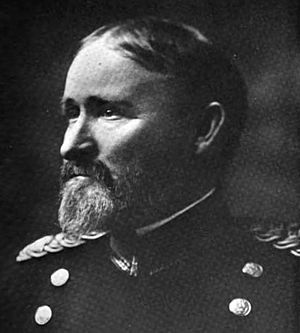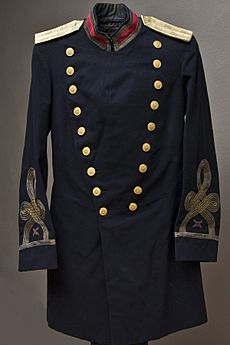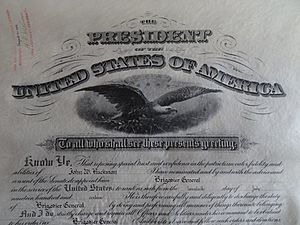John Wilson Ruckman facts for kids
Quick facts for kids
John Wilson Ruckman
|
|
|---|---|

From 1922's Fifty-third Annual Report of the Association of Graduates of the United States Military Academy
|
|
| Born | October 10, 1858 Sidney, Illinois |
| Died | June 6, 1921 (aged 62) Brookline, Massachusetts |
| Buried |
United States Military Academy Cemetery
|
| Allegiance | United States of America |
| Service/ |
United States Army |
| Years of service | 1883–1921 |
| Rank | Major General |
| Commands held | Southeastern Department Southern Department Northeastern Department |
| Awards | |
John Wilson Ruckman (born October 10, 1858 – died June 6, 1921) was a high-ranking officer, a major general, in the United States Army. He was known for his work in artillery and for commanding different military departments.
Contents
Early Life and Education
John Wilson Ruckman was born in a small place called Deers, Illinois. Most records, however, list his birthplace as Sidney, Illinois. His parents, Thomas and Mary O'Brien Ruckman, were farmers. His uncles fought bravely in the American Civil War.
John Ruckman studied at the University of Illinois for a while. Then, he was chosen to attend the United States Military Academy (West Point). This famous military school is where future army officers are trained.
Military Career and Achievements
Ruckman graduated from West Point in 1883. He also attended other important military schools. These included the U.S. Artillery School, the U.S. Army War College, and the U.S. Naval War College.
He was first stationed at Fort Hamilton, New York. There, he became friends with another important officer, Tasker Bliss. From 1881 to 1899, he served at Fort Monroe. Here, he and four other officers started a military newspaper called the Journal of the United States Artillery in 1892. He was also the editor of this newspaper for four years. His work helped the Journal become a highly respected military publication.
Ruckman was also an inventor. He created several devices for artillery that were very important during World War I.
Assignments and Commands
After a short time at Fort Slocum, Ruckman went to Havana, Cuba. Later, he became an instructor at the School of Submarine Defense. This school was located at Fort Totten in New York. While teaching about chemistry and explosives, he became friends with Arthur L. Wagner.
In 1906, Ruckman was sent to the Presidio of San Francisco. He was given command of Fort Baker. In 1911, he took command of Fort Mills in Corregidor. There, he showed great skill by successfully defending the fort during a difficult situation. In 1916, he was put in charge of forming a new artillery regiment in Texas. He also commanded military districts in Texas.
During World War I, Ruckman commanded three different military departments in the United States:
- The Southeastern Department (starting August 1917)
- The Southern Department (starting September 1917)
- The Northeastern Department (starting May 1918)
He was the only person to command three of the six main military departments in the U.S. at that time.
Challenges and Controversies
Ruckman's career had some challenging moments. While at West Point, he faced some difficulties. In 1915, he wrote a paper for the Naval War College. In it, he suggested that all young men should receive military training and learn how to use firearms. He also believed that history textbooks in schools should follow certain rules.
Ruckman was involved in a difficult situation after the Houston riot of 1917. He was the commander of the Southern Department at the time. His actions during this period led to changes in military rules. The Department of War decided that no death sentence given by a military court in the U.S. could be carried out without the President's personal review. Although President Woodrow Wilson supported Ruckman publicly, Ruckman was later quietly removed from his command in May 1918. He was also reduced in rank to a brigadier general. His actions were also looked into during special hearings in 1919.
In 1918, he tried to influence laws about what languages could be taught in Texas public schools. He wanted to ban the teaching of German.
Later, in 1920, Ruckman had a public disagreement with Charles W. Eliot of Harvard University. They disagreed about the quality of military education in the United States. In 1921, Ruckman suggested that immigrants could serve in the military for a period of time. He thought this would help them become part of American society. That same year, he made headlines by deciding that soldiers under his command would not march in Boston's St. Patrick's Day parade. The Secretary of War supported his decision.
Awards
John Wilson Ruckman received the Army Distinguished Service Medal. This award was given to him after his death.
Family Life
John Ruckman married May Hamilton. Her father was Colonel John Hamilton, a hero from the American Civil War.
Ruckman's only son, John Hamilton Ruckman, was also very accomplished. He was an engineer who worked on the top-secret Manhattan Project during World War II. John Wilson Ruckman is also the grandfather of Peter Sturges Ruckman, a religious leader. His great-grandson, P.S. Ruckman Jr., is a political science professor.
Death and Legacy
General Ruckman passed away in 1921. He was buried at the famous West Point military cemetery. Many high-ranking officers attended his funeral. The U.S. Military Academy Band played music, and a special gun salute honored him.
A military base in Massachusetts was later renamed "Fort Ruckman" in his honor. Today, streets are also named after him at the Presidio of San Francisco, in Fort Monroe, Virginia, and in Fort Bliss, Texas. A granite column with his name is also at the University of Illinois' Memorial Stadium.
Dates of Rank
| Second Lieutenant, Regular Army: June 13, 1883 | |
| First Lieutenant, Regular Army: Feb. 20, 1891 | |
| Captain, Regular Army: March 31, 1899 | |
| Major, Regular Army: June 30, 1906 | |
| Lieutenant Colonel, Regular Army: Feb. 2, 1911 | |
| Colonel, Regular Army: March 7, 1912 | |
| Brigadier General, Regular Army: July 20, 1916 | |
| Major General, National Army: Aug 5, 1917 | |
| Returned to grade of Brigadier General, Regular Army: May 1, 1918 | |
| Major General, Regular Army: June 7, 1921 (Awarded Posthumously) |
Selected Writings
John Wilson Ruckman wrote many articles and papers during his career. Here are a few examples:
- "Ballistics: The Wind Problem in Gunnery." 1890.
- "Artillery Difficulties in the Next War." 1892.
- "The Effect of Wind Upon the Motion of a Projectile." 1892.
- "Coast Artillery Fire Instruction." 1894.
- "Investigation of the Comparative Values of Concentrated and Parallel Methods of Mortar Fire." 1896.
- "Are Disappearing Gun Carriages Essential to Our Coast Defense?" 1902.
- "Coast Artillery Practice." 1908.
- "The Journal of the U.S. Artillery." 1912.
- "Siege of Port Arthur" 1915.
- "The Policy of the United States." 1915. (His thesis for the U.S. Naval War College)
- "Military and Naval Cooperation." 1917.
Images for kids




